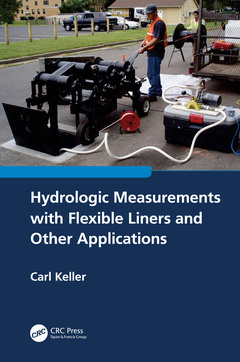Hydrologic Measurements with Flexible Liners and Other Applications
Auteur : Keller Carl

This book provides hydrologists the information needed for the characterization of contaminated subsurface hydrologic sites. It explains how to seal boreholes, map contaminant distribution in a formation, map the flow zones, and measure the hydraulic head distribution through a single flexible liner. Results of the measurement methods provided demonstrate the reality and reliability of the unique FLUTe techniques. These measurements help to predict contaminant migration and aid in the design of a groundwater remedy. The limitations of several methods are provided to allow an intelligent choice of methods and a well-informed selection of devices among the alternative methods. The mechanics of flexible liner systems are explained with examples of applications beyond the hydrologic measurements such as relining of piping.
Features include:
- The first book on a modern technology that is replacing traditional technology globally
- Written by the inventor of the FLUTe technology with 25 years? experience with successful applications
- Describes FLUTe technology in detail, including the theory behind the tools, how to use the tools, and the mathematics used to interpret the data generated by the tools
- Provides step-by-step explanations of how to conduct fieldwork and how to analyze the data gathered
- Minimizes reliance on mathematical explanations and uses illustrations and examples that allow readers to understand the technology
This book is of interest to environmental professionals, mine operators, petroleum engineers, geophysicists who use these methods or are considering using these methods for remediation of groundwater contamination, academics, students, and regulators.
1. Introduction/Purpose 2. Brief History of Flexible Liner Underground Technologies (FLUTe) Methods 3. The Mechanics of Flexible Liners 4. Chemistry of the Liners 5. Kinds of Blank Liners 6. Novel Applications of Blank Liners 7. General Advantages of Flexible Blank Liners 8. Hazards to the Liner and Precautions 9. Special Devices Designed for Use with Liners 10. Theory and Application of FLUTe Liner Methods 11. FLUTe Vadose Multi-Level Measurements 12. The TACL (Traveling Acoustic Coupling Liner) 13. Application of Combinations of Liners and Other Methods 14. CSC (Continuous Screened Casing) Design 15. Other Applications of Liners 16. FLUTe Calculational Models 17. Installation Procedures of Many Kinds 18. The Manufacturing Machines and Facilities Developed for Liner Fabrication 19. Conclusion
Carl Keller is the owner and principal scientist of Flexible Liner Underground Technologies (FLUTe), a business of fabricating and installing the products of his inventions which include a wide range of unique underground measurement methods and monitoring techniques related to ground water contamination. At FLUTe, he performs the duties of principal scientist and CEO. He also serves as a consultant on matters of his scientific experience. He has patents on multi-level ground water sampling methods, hydraulic conductivity measurements in boreholes, the lining of ducting for decontamination, a progressive packer device for horizontal holes, liner augmentation of horizontal drilling, DNAPL mapping, mapping the dissolved phase of
contaminants, mapping the vertical head distribution, and rehabilitation of piping and sewer lines. He has 30 patents on underground measurement methods, 29 use flexible liners. He has patents in 13 foreign countries. His methods are in use
in all 50 States, Canada, Brazil, Japan, Denmark, Sweden, France, UK, Israel, Saudi Arabia, Australia, South Africa, South Korea, Germany, and Spain. In 2008 he received the National Groundwater Association Technology Award.
Date de parution : 07-2022
15.6x23.4 cm
Thèmes de Hydrologic Measurements with Flexible Liners and Other... :
Mots-clés :
Groundwater sampling; Groundwater flow; Mapping hydraulic conductivity; Fracture characterization; Fracture identification; Contaminate distribution; Contaminant migration; Ground water flow; Water quality assessment; Acoustic geologic mapping; Flexible Liners; Fact; Inverted Liner; Borehole Wall; Hole Wall; Open Borehole; FLUTe Methods; Blank Liner; Sand Pack; Water Table; Artesian Head; Excess Head; Grout Fill; Liner Velocity; Water Level; Shallow Water Tables; Deep Water Tables; Pump Tube; Straddle Packer; Hydrologic Measurements; WT; Water Table Depth; Vadose Zone; Purge Volume



